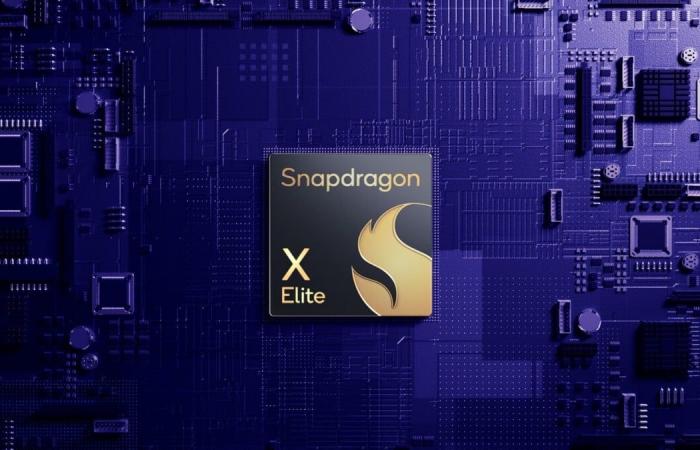Asus is following in the footsteps of the competition with its Vivobook S 15, the brand’s first computer to integrate Qualcomm’s new Snapdragon X Elite chip. While waiting for a more in-depth test in the coming days, here are our very first performance measurements.
The first wave of AI PCs is available to order today from many manufacturers. These highly anticipated machines offer two major new features: the brand new Snapdragon X Elite chip based on ARM architecture and the new version of Windows 11 with certain Copilot features.
The promises are numerous: more powerful, more autonomous and more intelligent laptops thanks to Windows AI functions accelerated by the presence of an NPU (neural processing chip). The major challenge is to catch up with Apple on its territory, that of performance per watt.
We received a copy of the ASUS Vivobook S 15 in advance, the brand’s first PC to offer the new Qualcomm chip. While waiting for a more complete test by the end of the week, we ran the machine through several benchmarks to confirm or refute the figures that have been communicated in recent months.
The testing machine
First of all, here is some information to know about the Asus laptop that we used for this test. The ASUS Vivobook S 15 integrates the least powerful version of the Snapdragon boost possibility (up to 4.3 GHz on the most powerful version). GPU level, we are also on a less powerful version, with a nominal raw power of 3.8 TFLOPS (compared to 4.6 on the maximum of the range).
We are therefore facing a Snapdragon X Plus which would have gained 2 additional cores (12 against 10, therefore). It should therefore be kept in mind that these figures are not indicative of the potential of the chip, Asus having chosen the least powerful SKU on this model. This is also a good thing, because depending on the results of our various benchmarks, the room for improvement could therefore be significant on other machines.
| Model | ASUS Vivobook S 15 (S5507) |
|---|---|
| Screen size | 15.6 inches |
| Definition | 2880 x 1620 pixels |
| Display technology | OLED |
| Touch screen | No |
| Processor (CPU) | Snapdragon X Elite X1E 78 100 |
| Graphics chip (GPU) | Qualcomm Adreno GPU |
| RAM | 32 GB |
| Internal memory | 1024 GB |
| Operating system (OS) | Microsoft Windows 11 Pro |
| Weight | 1420 grams |
| Height | 14.7mm |
| Product sheet |
We compare the chip’s performance with similar mobile models from Intel (Core Ultra 7 155H) and AMD (Ryzen 7 7840HS), as well as the M3 chip found in the latest 13-inch MacBook Air.
Processor performance: the gains are there
Let’s first look at the raw performance of the processor part of the Snapdragon X Elite SoC. We focused our test on the Cinebench suite in its 2024 version, before confirming some of the deviations from the previous version, R23 when possible. Indeed, many synthetic tests are not yet compatible with the ARM platform.
On Cinebench 2024, the Asus Vivobook S 15 reached 1129 points in multi-core and 107 in single-core. This is simply the performance of an M3 Pro chip present in the latest MacBook Pro.
The chip is also significantly more efficient than the Intel Core Ultra 7 155H (+40%) and slightly above the Intel Core Ultra 9 185H (+19%), the high-end version of the Meteor Lake chips. .
Compared to AMD, the gap is also widening, with a gap of almost 27% in favor of the Snapdragon X Elite. As a reminder, here we are testing the least powerful version of the Qualcomm chip, so these figures are very promising for the rest of the range, in terms of pure performance.
| Cinebench R24 (Multi) | Cinebench R24 (Single Player) | |
|---|---|---|
| Snapdragon X Elite (X1E-78-100) | 1129 | 107 |
| Intel Core Ultra 7 155H | 703 | 104 |
| AMD Ryzen 7 7840HS | 891 | 102 |
| Apple M3 | 558 | 142 |
It is in single-core that this becomes complicated, with performances which struggle to exceed 110 in the same test, very slightly above its competitors at AMD and Intel, but much lower than Apple’s M3, including in its base version on the MacBook Air. Compared to Apple, the Snapdragon remains 25% below, so the room for improvement remains significant for the other models in the range.
Note that like all MacBooks show the same level of performance, whether plugged in or on battery. The Vivobook S 15 chip does not maintain the high performance profile once the computer is unplugged, with performance 50% lower in multi-core and 33% lower in single-core.
In silent mode and on mains, however, the Snapdragon always remains on top. It’s already that.
Tests in progress for the GPU and AI and creativity part
The game gets complicated for the GPU part and artificial intelligence. Our various synthetic benchmarks show performances that are very much lower than competing machines, so much so that we still doubt their veracity for the moment. We will try to carry out in-game testing
However, we had time to perform some tests on Cyberpunk 2077 with High graphics settings, without ray tracing, and we achieved an average of 23 FPS at 1080p with AMD’s FSR in Quality mode. Microsoft’s DirectSR can be used, with similar performance, around 24 frames per second, for truly convincing image quality.
Like Intel, we expect numerous driver-level iterations to significantly improve performance over the months on the most played games using the DirectX 12 and 11 API.
Promising results, but the road will be long
You have noticed with this brief overview of the performance of the Snapdragon Not all applications use multithreading, this is a point on which Qualcomm’s new platform may lag behind.
The crux of the matter will be in the consumption of the chip and therefore its autonomy, tests that we will do in the coming days on the machine as well as the next ones which will arrive this month from other manufacturers.







